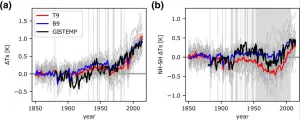(Press-News.org) CHAMPAIGN, Ill. -- A smartphone app called Harbor, currently under development by researchers at the University of Illinois Urbana-Champaign, teaches young adults how to talk to a peer if they are concerned about that other person's drinking or drug use.
Designed for people ages 18-29, Harbor teaches young adults how they can "act as first responders for their close friends who demonstrate risky substance use behaviors," according to the app's lead developer, social work professor Douglas C. Smith. Smith, the director of the Center for Prevention Research and Development at the U. of I., focuses his research on substance use and interventions for young people.
While young adults have the highest rates of substance use, they are also the people least likely to seek treatment, he said.
"If you're an individual who gets referred to treatment, or who is in need of treatment, it's pretty likely that people in your social network are worried about you," he said. "And there's probably a mix of people in your social network who also have elevated substance use as well."
In an online survey of more than 450 young adults conducted for the current study, 45% of the respondents indicated that they were concerned about a close friend's drug or alcohol use. The study was published in the Journal of Medical Internet Research.
"If they're responding affirmatively to that question, there's a good chance their friend is probably using at some sort of risky level," said graduate student Kyle M. Bennett, the first author of the study.
"They're probably not just an occasional user; they're probably going out frequently and experiencing some of those nasty side effects of whatever substance they may be using."
However, while many young people may be troubled by friends' drug or alcohol use, many of them are also uncertain how to talk with them about it, Bennett said.
"You hear this often: 'I would have done something, but I just didn't know what to do or I didn't know what to say or how to approach the topic,'" Bennett said. "The Harbor app guides them in supporting their friend without being confrontational or enabling."
The app prompts the user to answer several questions about their friend's substance use behaviors and provides feedback on the potential seriousness - a feature that may be especially helpful to people who feel conflicted about intervening, Smith said.
Smith said the idea for the mobile phone app sprang from a prior project, funded by a five-year grant from the National Institute on Alcohol Abuse and Alcoholism, that explored the efficacy of having young people with alcohol or marijuana problems invite a close friend to participate in some of their treatment sessions with them to provide social support.
"Since young adults have really low rates of coming to treatment, we thought that this peer model might be a way of expanding the benefits of treatment to people who don't usually seek it," Smith said. "A surprising finding from that study was that both the client and their friend made changes in their substance use behaviors and got better within six months."
That study, published in the Journal of Substance Abuse Treatment in 2015, found that both the client and their friend reduced their binge drinking and increased the number of days that they abstained. Smith's co-authors were Western Ontario University psychology professor Tara Dumas and then-U. of I. graduate students Jordan P. Davis and the late Daniel J. Ureche.
Harbor provides the app user with possible text messages and dialogues for conveying their concerns to their friend. Smith said a challenge for the team was writing messages that could be applied in differing situations without being overly generic and that also sounded conversational and reflected young people's speech patterns.
"Ultimately, you're trying to communicate a message while encouraging them to adopt some of these practices and empowering them to put it in their own words when they talk with their friend," Smith said.
When young adults in the study reviewed the sample scripts and messages, "more than 95% of them indicated the scripts would be useful in talking with their friends about their substance use," Bennett said. "And about 98% of respondents rated the script dialogues as realistic. If young adults felt the language in the scripts was inauthentic, I think it's safe to assume they would be less likely to use the app."
Participants also were asked to evaluate the language in the app's messages and rate each of them as supportive, enabling or confrontational. While most of the participants accurately identified the enabling and confrontational responses, they were less consistent at recognizing the supportive responses, Smith said.
The researchers were uncertain why that occurred but said it may have been because participants had not been given the app's educational module first and lacked the information or personal experience to accurately interpret supportive responses.
The team is currently refining and beta-testing the Harbor app to deploy it in a controlled trial with young adults and their friends in a clinic setting this spring.
INFORMATION:
In addition to Smith, the co-authors of the study included social work professor Kelly Lynn Clary of Texas State University and U. of I. graduate student Carol Ann Lee. The study was supported by the Substance Abuse and Mental Health Service Administration and the U. of I. Office of Technology Management.
Boulder, Colo., USA: GSA's dynamic online journal, Geosphere,
posts articles online regularly. Topics for articles posted for Geosphere this month include "a tale of five enclaves"; evidence
for mantle and Moho in the Baltimore Mafic Complex (Maryland, USA); and the
after effects of the 1964 Mw 9.2 megathrust rupture, Alaska.
From Ordovician nascent to early Permian mature arc in the southern
Altaids: Insights from the Kalatage inlier in the Eastern Tianshan, NW
China
Qigui Mao; Jingbin Wang; Wenjiao Xiao; Brian F. Windley; Karel Schulmann
...
Abstract:
The Kalatage inlier in the Dananhu-Haerlik arc is one of the most important
arcs in the Eastern Tianshan, southern Altaids ...
BROOKLYN, New York, Wednesday, March 3, 2021 - Machine-learning (ML) systems are becoming pervasive not only in technologies affecting our day-to-day lives, but also in those observing them, including face expression recognition systems. Companies that make and use such widely deployed services rely on so-called privacy preservation tools that often use generative adversarial networks (GANs), typically produced by a third party to scrub images of individuals' identity. But how good are they?
Researchers at the END ...
Nature Communications Publishes Paper by Lundquist Institute Investigator Dr. Wei Yan and Colleagues on New Promising Compound for Male Contraceptive Pill
The Lundquist Institute researchers discovered a natural compound that exhibits almost ideal male contraceptive effects in pre-clinical studies
LOS ANGELES (March 3, 2021) -- In a new paper published by Nature Communications, The Lundquist Institute (TLI) Investigator Wei Yan, MD, PhD, and his research colleagues spell out an innovative strategy that has led to the discovery of a natural compound as a safe, effective and reversible male contraceptive agent in pre-clinical animal models. ...
A recent analysis of the latest generation of climate models -- known as a CMIP6 -- provides a cautionary tale on interpreting climate simulations as scientists develop more sensitive and sophisticated projections of how the Earth will respond to increasing levels of carbon dioxide in the atmosphere.
Researchers at Princeton University and the University of Miami reported that newer models with a high "climate sensitivity" -- meaning they predict much greater global warming from the same levels of atmospheric carbon dioxide as other models -- do not provide a plausible scenario of Earth's future climate.
Those ...
Inspired by the eyes of mantis shrimp, researchers have developed a new kind of optical sensor that is small enough to fit on a smartphone but is capable of hyperspectral and polarimetric imaging.
"Lots of artificial intelligence (AI) programs can make use of data-rich hyperspectral and polarimetric images, but the equipment necessary for capturing those images is currently somewhat bulky," says Michael Kudenov, co-corresponding author of a paper on the work and an associate professor of electrical and computer engineering at North Carolina State University. "Our work here makes smaller, more user friendly devices possible. And that would allow us to better bring those AI capabilities to bear in fields from astronomy to biomedicine."
In the context of this research, ...
Researchers have analyzed tracking data for 5,775 birds across 39 species of albatrosses and large petrels -- threatened seabirds whose ranges span many countries and the high seas -- to estimate how responsibility for their protection should be distributed among nations and international organizations. The authors note that albatrosses and large petrels from all breeding countries spend much of their time on the high seas, indicating that effectively managing these waters is of global interest. These estimates are critical to inform ongoing United Nations discussions to design a global treaty for conserving biodiversity in the high seas, beyond national jurisdictions, the authors write. Many species of albatrosses and ...
CHAPEL HILL, N.C. - First-year college students are reporting symptoms of depression and anxiety significantly more often than they were before the coronavirus pandemic, according to a study by the University of North Carolina at Chapel Hill.
The study, embargoed for release until March 3, 2021, at 2 p.m. EST, in the journal PLOS ONE, is based on surveys of 419 Carolina students, and reflects the challenge of colleges nationwide to support student well-being.
The study is unique among the growing reports of COVID-19's toll on mental health: researchers followed the ...
The source of potentially hazardous solar particles, released from the Sun at high speed during storms in its outer atmosphere, has been located for the first time by researchers at UCL and George Mason University, Virginia, USA.
These particles are highly charged and, if they reach Earth's atmosphere, can potentially disrupt satellites and electronic infrastructure, as well as pose a radiation risk to astronauts and people in airplanes. In 1859, during what's known as the Carrington Event, a large solar storm caused telegraphic systems across Europe and America to fail. With the modern world ...
A huge volume of digital data has been harvested, stored and shared in the last few years - from sources such as social media, geolocation systems and aerial images from drones and satellites - giving researchers many new ways to study information and decrypt our world. In Switzerland, the Federal Statistical Office (FSO) has taken an interest in the big data revolution and the possibilities it offers to generate predictive statistics for the benefit of society.
Conventional methods such as censuses and surveys remain the benchmark for generating socio-economic indicators at the municipal, cantonal and national levels. But these methods can now be supplemented with secondary, mostly pre-existing data, from sources such as cell-phone ...
More than five years after receiving an experimental immunotherapy drug, half of a group of people at high risk of developing Type 1 diabetes remained disease-free compared with 22% of those who received a placebo, according to a new trial overseen by Yale School of Medicine researchers.
And those who developed diabetes did so on average about five years after receiving the new drug, called teplizumab, compared with 27 months for those who received the placebo.
The study, which was done in collaboration with researchers from Indiana University, was published March 3 in the journal Science Translational Medicine.
"If approved for use, this will be the first drug to delay or prevent Type 1 diabetes," ...




